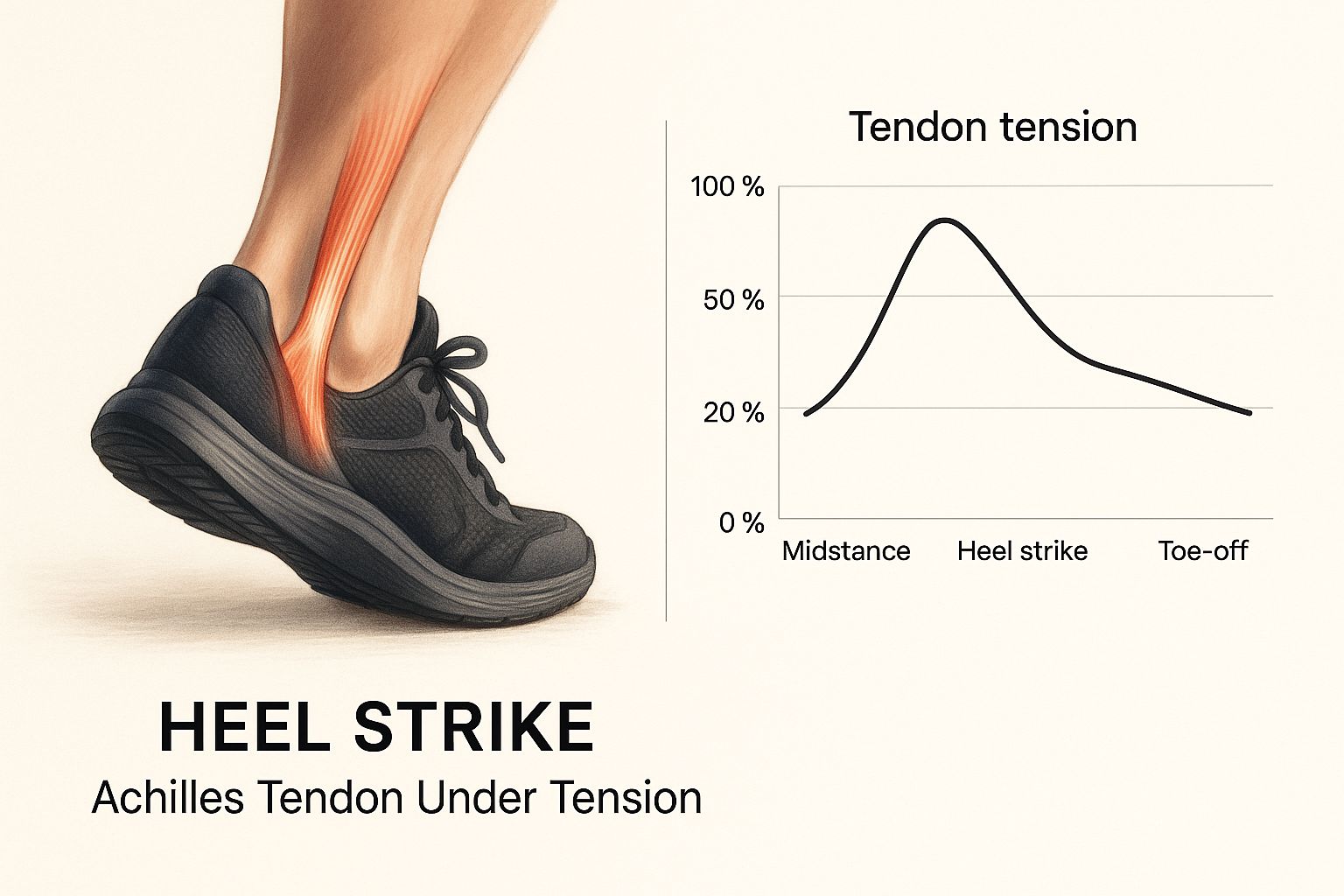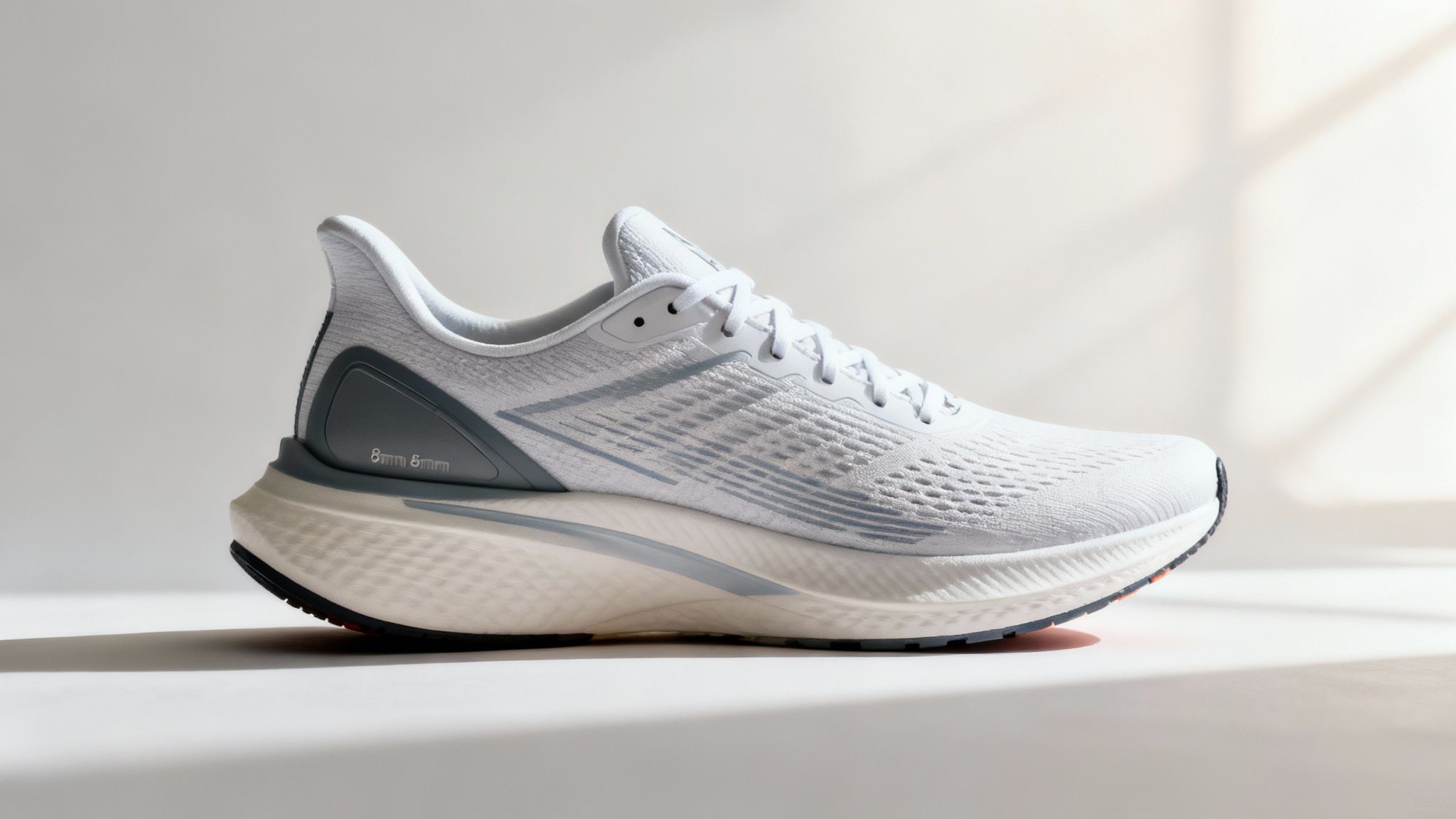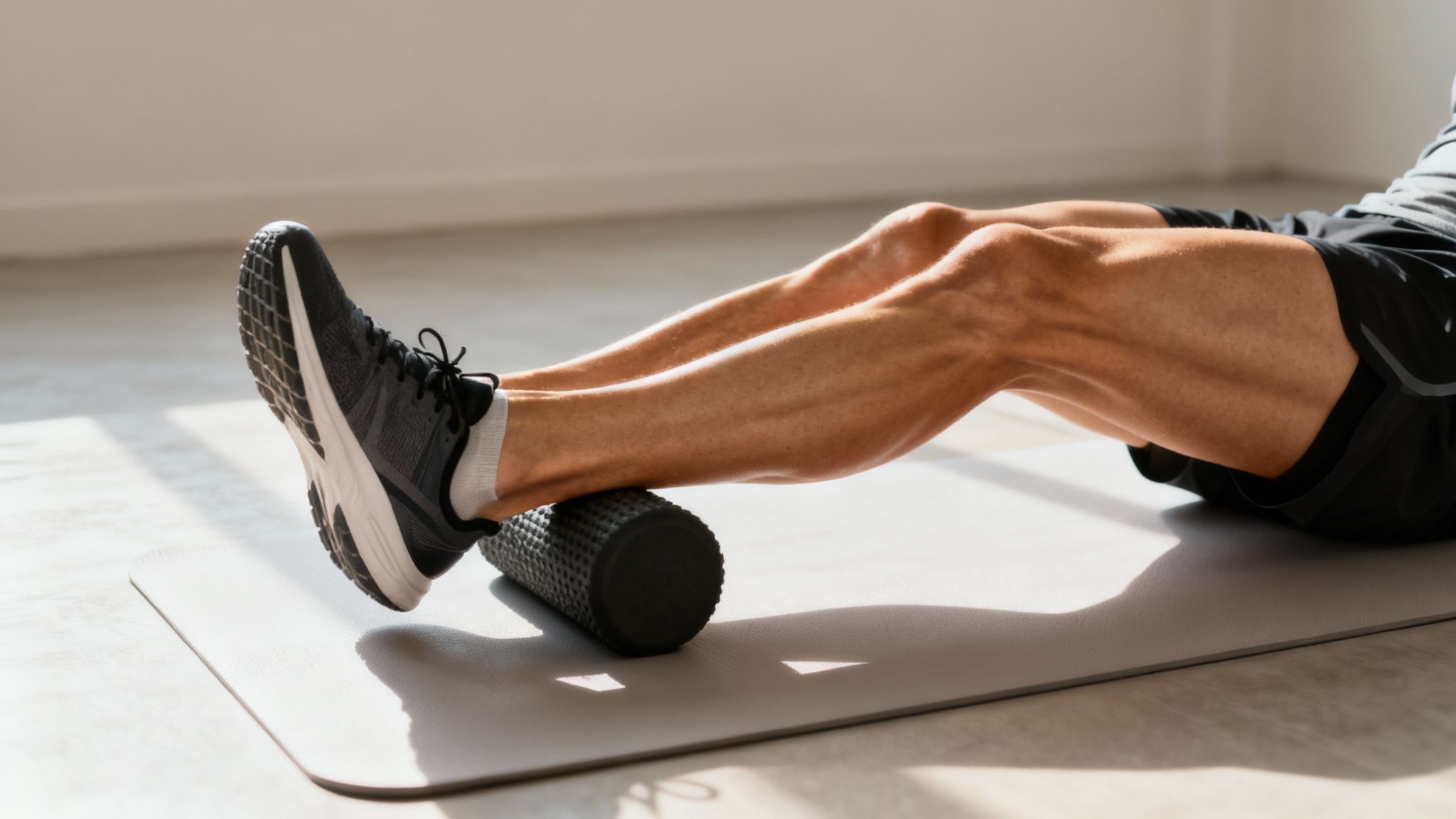Best Running Shoes for Achilles Tendonitis
- Flourish Everyday Health And Fitness

- 6 days ago
- 9 min read
Updated: 5 days ago
Most active people have felt heal discomfort. Dealing with Achilles tendonitis means that nagging pain can turn a good run into a miserable experience, and in some cases put you down for months.
The right shoes aren't just about comfort, they're a critical tool for managing the immense stress your Achilles tendon endures with every step. Your Achilles is the largest tendon in your body and handles forces up to 10 times your body weight during a run. The shoes you wear are your first line of defense, dictating how that impact travels up your leg.
When choosing the best running shoes for Achilles tendonitis, you're looking for a specific combination: a higher heel-to-toe drop (8mm or more), generous cushioning, and a solid, supportive heel counter. These three features work together to take the strain off your tendon, preventing painful overstretching.

Index of Topics
How Running Shoes Impact Achilles Tendonitis
The pain you feel signals that your body's mechanics are out of balance, and your shoes can either help or hurt. An improper shoe can throw your entire kinetic chain off, exacerbating issues like overpronation (where your foot rolls too far inward) and putting a twisting force on the tendon.
The Biomechanics of Tendon Strain
Your biomechanics, the way your body moves, play a massive role. Weakness anywhere from your feet to your hips can force the Achilles to pick up the slack, leading to overuse and inflammation. This is where the right shoe design becomes so important. This visual shows how much tension the Achilles is under when your heel strikes the ground.

Good cushioning and support are crucial for absorbing ground forces before they can overload the tendon. One study highlighted that runners with Achilles problems often had weaker calf muscles and strength deficits in their hips and knees. These imbalances disrupt running form, leaving the Achilles to take the brunt of the impact. You can read more about the factors linked to Achilles tendinopathy.
Choosing the right running shoe isn't about finding the most popular model. It's about finding the one that corrects your specific biomechanical inefficiencies and reduces daily strain on your Achilles tendon.
A good running shoe acts as a support system engineered to protect you by:
Reducing Tendon Load: A higher heel drop gives your heel a slight lift, shortening the calf tendon complex and providing immediate relief from tension.
Controlling Unwanted Motion: Stability features like a firm heel counter and a supportive midsole stop your foot from rolling excessively, which prevents the twisting that aggravates the tendon.
Absorbing Shock: Quality cushioning soaks up the impact from each footstrike, protecting your tendon from repetitive micro traumas.
Understanding this connection empowers you to turn footwear from a potential source of pain into a powerful tool for recovery.
Essential Shoe Features to Reduce Achilles Strain
When dealing with a sensitive Achilles, you need to zero in on specific, non-negotiable features that will take the load off that tendon.

These key components work together to create a supportive ride that helps your foot move more efficiently and gives your overworked tendon a break.
The Importance of Heel-to-Toe Drop
One of the first numbers to look for is the heel-to-toe drop, or "offset." For Achilles relief, a higher drop is best. Look for shoes with a drop of at least 8mm, though many find their sweet spot in the 10mm to 12mm range. This elevation in the heel slightly shortens the calf muscle and reduces how far the Achilles tendon has to stretch with each stride.
Firm Heel Counter for Stability
Next, check the heel counter, the part that cups your heel. It should be firm and structured, not flimsy. This feature is crucial because it locks your heel in place, preventing excessive sideward motion (pronation or supination) that can twist and aggravate an already sensitive Achilles. A stable heel is the bedrock of a stable gait.
A secure heel counter acts like a brace, preventing the micro movements at the back of your foot that accumulate into significant tendon strain over a run.
The Right Cushioning and Midsole Support
Cushioning is essential for absorbing impact, but the type matters. You want plenty of shock absorption without it feeling overly soft. An excessively plush foam can make your foot unstable, forcing your Achilles to work overtime to stabilize your landing. Look for a balanced, responsive foam that protects your joints while providing a solid platform.
If your foot tends to roll inward (overpronation), a shoe with medial post support or a dual density midsole can be a game changer. These features help guide your foot into a more neutral alignment, preventing stress on the Achilles. For a deeper dive, learn more in our expert guide on how to choose running shoes.
Quick Guide to Achilles Friendly Shoe Features
Use this table as a quick reference to identify key shoe components.
Shoe Feature | What It Provides | How It Protects Your Achilles |
|---|---|---|
High Heel-to-Toe Drop (8mm+) | Elevates the heel relative to the forefoot. | Reduces the stretch and tensile load on the tendon. |
Firm Heel Counter | Structural support that cups and secures the heel. | Prevents excessive side-to-side motion, reducing twisting strain. |
Balanced Cushioning | Shock absorption without excessive softness. | Protects the tendon from impact forces while providing a stable base. |
Medial Support (if needed) | Controls overpronation (inward rolling). | Prevents the twisting motion that directly stresses the Achilles. |
Top Shoe Recommendations for Men
For men dealing with tendon pain, the ideal shoe has a higher heel drop, good stability, and the right cushioning. Here are a few field-tested recommendations.
The best running shoes for Achilles tendonitis can vary depending on what caused the initial injury. The shoes below have been favored by fitness people to help relieve or eliminate the pain.
Brooks Ghost: A Daily Workhorse
The Brooks Ghost is a reliable neutral trainer known for consistent comfort. Its 12mm heel-to-toe drop immediately takes some of the strain off your Achilles, making it a top pick for daily miles. The DNA LOFT v2 foam is soft enough to absorb impact but doesn't feel mushy, ensuring your foot stays stable.
Hoka Clifton: The Max Cushion Contender
For a plush, cloud like feeling, the Hoka Clifton series is an excellent choice. Its heel drop is lower at 5mm, but the magic is in its rockered sole. This design rolls you through your stride, smoothing out foot motion and reducing the work your lower leg has to do. The massive stack of soft foam is incredible for shock absorption. To learn more, check out our review of the Hoka Men's and Women's Clifton 10 Sneaker.
A rocker shaped sole, like the one on the Hoka Clifton, propels you forward. This means your ankle doesn't have to bend as much during push off, which can be a huge relief for a sensitive Achilles.
Asics GEL-Kayano: A Stability Standout
For runners whose overpronation contributes to Achilles pain, a solid stability shoe is a must. The Asics GEL-Kayano is a legend in this category, built to provide serious support and stop the inward roll that twists the Achilles. The Kayano has a 10mm heel drop and its 4D GUIDANCE SYSTEM™ delivers adaptive stability. It's the shoe for runners who need both cushioning and control.
Top Shoe Recommendations for Women
Women’s specific shoe designs account for biomechanical differences, like a wider Q-angle and unique foot shapes. The core principles for protecting your Achilles still apply: higher heel drop, a solid heel counter, and supportive cushioning.
New Balance Fresh Foam X 880: The Versatile Neutral
The New Balance Fresh Foam X 880 is a reliable, versatile neutral shoe. It has a 10mm heel-to-toe drop, which is ideal for taking pressure off a sensitive Achilles tendon. The Fresh Foam X cushioning provides a soft landing that absorbs impact but remains responsive. It’s a true workhorse for daily miles.
Saucony Guide: The Lightly Stable Option
If you overpronate slightly, the Saucony Guide offers a modern, gentle approach to stability. It uses a feature called HOLLOW-TECH to subtly guide your foot into a more neutral position, preventing the twisting motion that can aggravate the Achilles tendon. With an 8mm drop, the Guide still gives you enough lift to provide relief.
This gentle guidance works with your stride instead of fighting against it, making it a top contender for running shoes for Achilles tendonitis.
Brooks Adrenaline GTS: The Trusted Stabilizer
The Brooks Adrenaline GTS is a legendary stability shoe for runners who need dependable support. Its GuideRails® support system acts like bumpers to keep your foot, knee, and hip in proper alignment. The shoe comes with a generous 12mm heel drop, which, paired with its stability features, makes it a fortress of protection for runners whose tendon issues are tied to overpronation.
Minimalist Shoes vs Modern Cushioned Trainers
The debate between minimalist shoes and modern high cushioned trainers is critical for recovery. Minimalist shoes have thin soles and a zero drop profile, encouraging a midfoot or forefoot strike. This can build strength in your feet and lower legs, but it also puts a massive new load on your calf and Achilles tendon.
What This Means for Your Achilles
That extra demand can be a double edged sword. Research shows that minimalist shoes can increase the thickness and stiffness of the Achilles tendon (Willy, 2019). While this indicates adaptation, it also means mechanical strain is higher. If you transition too quickly, you're asking for an overload injury. You can explore the Achilles tendon loading research to see the biomechanics at play.
For a runner already battling Achilles tendonitis, switching to minimalist shoes is often a recipe for disaster. Piling that much new tensile load onto an inflamed tendon can set your recovery back weeks or months.
The Case for Modern Cushioned Trainers
On the other end of the spectrum are modern maximalist shoes with high tech foam and, in some cases, carbon fiber plates. They are engineered to reduce the load on your body. The thick midsoles are incredible at shock absorption, and many have a rocker geometry, a curved sole that helps your foot roll effortlessly.
Less Muscle Strain: The rocker design means your calf and Achilles don't have to pull as hard to propel you forward.
Lower Joint Impact: The cushioning softens the forces on your ankle and other joints.
For runners with Achilles issues, this protective, high cushion approach is usually the smarter bet. These shoes offload the stressed tendon, giving it a chance to heal.
Beyond Shoes: Supporting Your Achilles Health
The right shoes are a huge step, but true Achilles health comes from a holistic approach that strengthens the entire kinetic chain and improves flexibility.

Strengthening Key Muscle Groups
Your Achilles is part of a chain of muscles. When your calves, glutes, or core are weak, the tendon absorbs more load than it should. A simple strengthening program should include:
Eccentric Heel Drops: The gold standard for Achilles rehab. Stand on a step with your heels off the edge. Rise on both feet, then slowly lower the affected heel below the step. Aim for 3 sets of 15 repetitions daily.
Calf Raises: Both straight leg and bent knee versions are essential for targeting the two main calf muscles.
Glute Bridges: Strong glutes provide stability and drive, taking workload off your lower legs.
By building strength in the muscles that support the Achilles, you are effectively offloading the tendon. This helps treat current inflammation and builds resilience against future flare-ups.
The Role of Warm-Ups and Cool-Downs
A proper routine before and after you run is crucial for injury prevention. A dynamic warm-up (light jogging, leg swings) prepares muscles and tendons for stress. After your run, a dedicated cool down with gentle, static stretching helps restore muscles and improve flexibility. For ideas, explore our guide to a smarter post-run stretching routine.
Tools like foam rollers or massage guns can release tightness in your calf muscles, directly decreasing the tension pulling on your Achilles tendon.
A Few Common Questions About Achilles Health
Let's tackle some common concerns runners have about long-term Achilles care.
How Often Should I Replace My Shoes to Prevent Achilles Issues?
The general rule is to replace your running shoes every 300-500 miles. Over that distance, the midsole foam compresses and loses its ability to cushion properly. When that cushioning goes, more impact travels up your leg, putting extra stress on your Achilles. If your shoes feel "flat" or the tread is worn, it's time for a new pair.
Can the Wrong Running Shoe Actually Cause Achilles Tendonitis?
Absolutely. A shoe with a very low or zero heel-to-toe drop can force your Achilles to overstretch with every stride. Similarly, if you overpronate and your shoes lack stability, the inward rolling can create a twisting force on your tendon. Over time, that unnatural strain can lead to inflammation.
Technologically advanced shoes with carbon fiber plates can offer protection. They have been shown to reduce forces at the ankle joint and lessen peak force on key calf muscles (Hebert-Losier et al., 2024). You can explore how modern shoes can protect the Achilles tendon.
Are Heel Lifts or Special Insoles a Good Idea?
Heel lifts can provide immediate, short-term relief during a painful flare-up by taking tension off the tendon. Think of them as a temporary band-aid. For long-term management, supportive insoles or custom orthotics can make a world of difference, especially if your tendonitis is tied to issues like flat feet or severe overpronation. Consult with a podiatrist or physical therapist to see if they're right for you.
References
Hébert-Losier, K., Finlayson, S.J. & Driller, M.W. (2024). Influence of modern running footwear on Achilles tendon loading and injury risk: a narrative review. Scientific Reports, 14(2042). https://doi.org/10.1038/s41598-024-52382-7
Willy, R.W. (2019). Innovations and pitfalls in the treatment of running injuries. Best Practice & Research Clinical Rheumatology, 33(2), 101421. https://doi.org/10.1016/j.berh.2019.06.001
At Flourish-Everyday, we're committed to providing the expert advice and top-tier shoe recommendations you need to run pain-free. Find the perfect shoe to support your Achilles health and empower your wellness journey today.


Comments